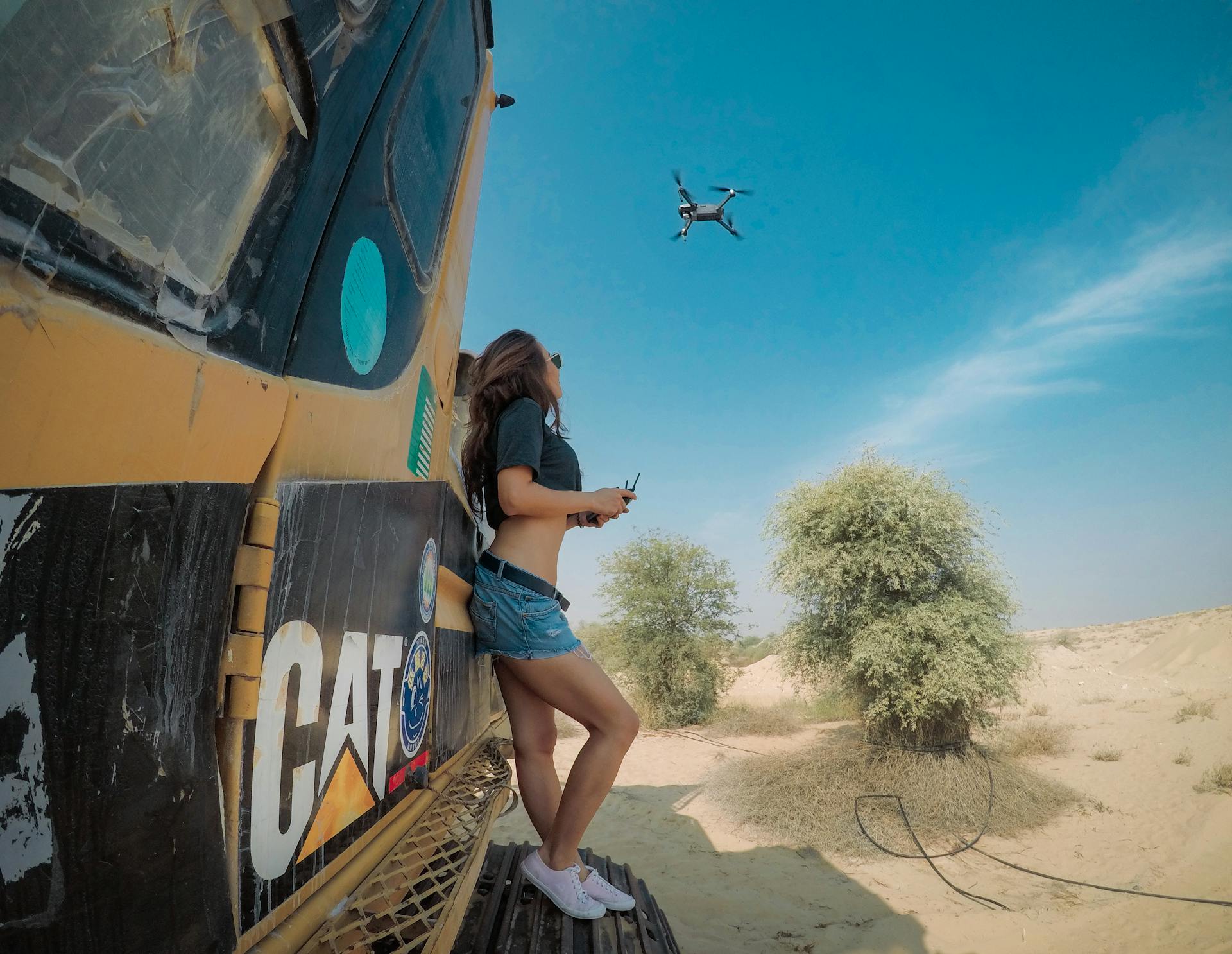
Unmanned aerial systems, or UAS for short, are becoming increasingly popular for both personal and commercial use. They're commonly known as drones.
These systems are capable of flying autonomously, using onboard sensors and GPS navigation to stay on course. Their ability to capture high-quality aerial footage and photos has made them a favorite among photographers and videographers.
UAS can be used for a variety of tasks, including surveying and mapping, search and rescue operations, and even package delivery.
What are UAS?
A UAS, or Unmanned Aerial System, is essentially a three-part system that allows an aircraft to fly without a human pilot on board.
An unmanned aircraft system typically includes an autonomous or human-operated control system, which can be located on the ground or on another airborne platform.
The control system is connected to a command and control system, which links it to the unmanned aerial vehicle, also known as a UAV.
These systems can be used for a variety of purposes, including remotely piloted air systems where the UAV is controlled by a 'pilot' using a radio data link from a remote location.
A UAS can also include an autonomous UAV or a semi-autonomous UAV.
Here are the three components of a UAS:
- Autonomous or human-operated control system
- Unmanned aerial vehicle (UAV)
- Command and control (C2) system
The weight of a small unmanned aircraft, which is part of a UAS, is defined as less than 55 pounds on takeoff, including everything that is on board or otherwise attached to the aircraft.
History and Development
The development of unmanned aerial systems (UAS) has a fascinating history. The first recorded use of large UAVs was in 1935, when the British Royal Navy began using adapted DH82 Tiger Moth aircraft called 'Queen Bees'.
These early UAVs were flown under radio control for gunnery target practice. A total of 380 of these 'Queen Bees' were built and used by both the Navy and the RAF before they were retired in 1947.
Military use of UAS has continued to evolve, with the use of satellite communications and GNSS navigation allowing UAVs to operate at very long distances from their controllers. This rapid development has led to the creation of a wide range of UAS types, including fixed wing, rotary, and multi-rotor models.
Recommended read: Use of UAVs in Law Enforcement
The Development of
The Development of UAS is a fascinating story that spans several decades. The first recorded use of large UAVs was in 1935, when the British Royal Navy began using adapted DH82 Tiger Moth aircraft called 'Queen Bees' which were flown under radio control for gunnery target practice.
These early UAVs were quite impressive, with a total of 380 built and used by both the Navy and the RAF before they were retired in 1947. The military has led the way in using UAVs, and it wasn't until recently that they became accessible to civil users.
In the early 1990s, the USA began to rapidly develop and utilize UAS, which marked a significant turning point in their development. The use of satellite communications and GNSS navigation allowed UAVs to operate at very long distances from their controllers.
The military's use of UAVs paved the way for the development of new types, including fixed wing, rotary, and multi-rotor UAVs. These newer designs have made UAVs more accessible to a wider range of users.
From a Vehicle
Operating a small unmanned aircraft system from a vehicle is heavily regulated. You can't operate one from a moving aircraft, period.
There are some exceptions for land or water-borne vehicles, but only if you're flying over a sparsely populated area and not transporting another person's property for compensation or hire. This is a pretty specific set of circumstances, but it's good to know it's allowed.
You'll also need to follow the provisions of sections 91.17 and 91.19 of this chapter, which means the person manipulating the flight controls or acting as a remote pilot in command or visual observer has to comply with those rules.
Civil Applications
Civil applications of unmanned aerial systems (UAS) are vast and diverse. Many of these uses are now well established.
Security surveillance is a common civil application, where UAS are used to monitor areas for potential threats. Emergency response teams also use UAS to locate missing people, such as in search and rescue (SAR) operations.
Facilitating communications and broadcast is another important use of UAS. This can include providing internet connectivity to remote areas or transmitting live video feeds.
Small package and bulk cargo transport is becoming increasingly popular, with UAS being used to deliver goods to hard-to-reach locations. Visual, spectral, and thermal examination of structures is also a growing field, where UAS are used to inspect buildings and infrastructure.
Monitoring linear network infrastructure, such as railway tracks, power lines, and pipelines, is a critical application of UAS. This helps to identify potential issues before they become major problems.
Here are some of the many civil applications of UAS:
- Security surveillance
- Emergency response (SAR)
- Facilitation of communications and broadcast
- Small package and bulk cargo transport
- Visual, spectral, and thermal examination of structures
- Monitoring of linear network infrastructure (railway tracks, power lines, pipelines)
- Photography and cartographic survey
- Agricultural fertiliser and chemical application
- Aircraft external maintenance inspection
- Atmospheric research
Regulations and Safety
The Joint Authorities for Rulemaking on Unmanned Systems (JARUS) oversees safety regulatory oversight of UAS operations and airworthiness on a supra-national basis. JARUS was established in 2007 and has 35 member states, including China and the Russian Federation.
To ensure safe operation, a remote pilot in command must check the small unmanned aircraft system before each flight to determine if it is in a condition for safe operation. This includes checking for any damage or malfunctions that could affect flight safety.
On a similar theme: UPS Flight Forward
The FAA requires remote pilots to report any serious injury or damage to property exceeding $500 in value within 10 calendar days. This helps to identify and address potential safety issues and prevent future incidents.
A remote pilot in command must also comply with operating limitations, including a maximum groundspeed of 87 knots (100 miles per hour), a maximum altitude of 400 feet above ground level, and a minimum flight visibility of 3 statute miles.
Part 107—Systems
Any operation that a person elects to conduct under part 91 of this chapter with a small unmanned aircraft system that has been issued an airworthiness certificate is allowed.
A small unmanned aircraft system that has been issued an airworthiness certificate can be used for operations under part 91 of this chapter.
The FAA will issue a notice either affirming the rescission or withdrawing the rescission upon consideration of the information submitted under paragraph (e)(1) of this section.
Multiple amendments have been made to Part 107, with Amdt. No. 107-8 being referenced in 86 FR 4382, Jan. 15, 2021, and 86 FR 4383, Jan. 15, 2021.
If this caught your attention, see: Remote Pilot Small Unmanned Aircraft Systems Study Guide
Safety Regulation
The safety regulation of drones is a complex but crucial aspect of their operation. JARUS, a group of experts from National Aviation Authorities, aims to provide a single set of technical, safety, and operational requirements for the certification and safe integration of UAS into airspace and at aerodromes.
The FAA requires remote pilots to report any operations involving serious injury or property damage within 10 calendar days. This includes damage to property worth over $500 or serious injury to any person.
To ensure a safe operation, the remote pilot in command must check the small unmanned aircraft system prior to each flight. This includes checking for any damage or malfunctions that could affect the aircraft's safe operation.
The maximum altitude for small unmanned aircraft is 400 feet above ground level, unless flying within a 400-foot radius of a structure. The groundspeed of the small unmanned aircraft may not exceed 87 knots (100 miles per hour).
To operate a small unmanned aircraft in certain airspace, such as Class B, Class C, or Class D airspace, or within the lateral boundaries of the surface area of Class E airspace designated for an airport, you need prior authorization from Air Traffic Control (ATC).
The remote pilot in command may deviate from any rule in the event of an in-flight emergency, but must report the deviation to the Administrator upon request. A visual observer is required if the small unmanned aircraft is operated beyond visual line of sight.
Waiver Policy
To obtain a waiver, you must submit a request that includes a complete description of your proposed operation and justification for why it can be safely conducted under the terms of a waiver.
The Administrator may issue a certificate of waiver if they find that your proposed operation can be safely conducted under the terms of that certificate.
You'll need to explain how your operation will meet safety standards and comply with regulations.
The Administrator may prescribe additional limitations that they consider necessary for your waiver.
If you receive a certificate of waiver, you'll be allowed to deviate from certain regulations, but you'll still need to comply with any conditions or limitations specified in the certificate.
Some regulations that can be waived include operating from a moving vehicle or aircraft, but note that no waiver will be issued for carrying property of another by aircraft for compensation or hire.
You'll also need to comply with regulations regarding anti-collision lights, visual line of sight, and operation over people.
The Administrator may not issue a waiver to allow the carriage of property of another by aircraft for compensation or hire, so be sure to check the regulations carefully.
If you're planning to operate multiple small unmanned aircraft systems, you'll need to comply with regulations regarding visual observers and operating limitations.
Remember to always yield the right of way and comply with regulations regarding operation in certain airspace and over moving vehicles.
At Night
Operating a small unmanned aircraft system at night requires special consideration. The remote pilot in command must have completed an initial knowledge test or training after April 6, 2021, to operate at night.
The small unmanned aircraft must have lighted anti-collision lighting visible for at least 3 statute miles with a flash rate sufficient to avoid a collision. The remote pilot in command may reduce the intensity of the lighting but not extinguish it, unless it's in the interest of safety.
Civil twilight is a critical period to be aware of when operating a small unmanned aircraft system. It begins 30 minutes before official sunrise and ends at official sunrise, except for Alaska.
The remote pilot in command must observe the airspace for other air traffic or hazards, and be aware of the need for lighted anti-collision lighting during this period. The lighting must be visible for at least 3 statute miles.
In Alaska, the period of civil twilight is defined in the Air Almanac. This is an important consideration for remote pilots operating in this region.
For another approach, see: Micro Air Vehicles
Operating Rules
Operating a small unmanned aircraft requires you to yield the right of way to all aircraft, airborne vehicles, and launch and reentry vehicles. This means giving way to these vehicles and not passing over, under, or ahead of them unless you're well clear.
You must also avoid operating your small unmanned aircraft so close to another aircraft that it creates a collision hazard. This is crucial to preventing accidents and ensuring safe airspace.
The groundspeed of your small unmanned aircraft should not exceed 87 knots (100 miles per hour), and you must maintain an altitude of no more than 400 feet above ground level. However, if you're flying near a structure, you can fly higher than 400 feet, but only up to the structure's immediate uppermost limit.
Near Right-of-Way Rules
Near Right-of-Way Rules are crucial for safe operation of small unmanned aircraft. They dictate how to navigate around other aircraft and vehicles in the air.
For more insights, see: Dji - Mini 2 Se Drone with Remote Control
You must yield the right of way to all aircraft, airborne vehicles, and launch and reentry vehicles. This means giving way to the aircraft or vehicle and not passing over, under, or ahead of it unless you're well clear.
No person may operate a small unmanned aircraft so close to another aircraft as to create a collision hazard. This rule is in place to prevent accidents and ensure safety in the skies.
Visual Observer
Using a visual observer during small unmanned aircraft system operations can be a great way to maintain a safe and effective flight. According to § 107.33, a visual observer must be used if the remote pilot in command, the person manipulating the flight controls, and the visual observer cannot maintain a visual line of sight with the aircraft.
The remote pilot in command must ensure that the visual observer can see the unmanned aircraft in the manner specified in § 107.31. This means the visual observer must be able to see the aircraft's location, attitude, altitude, and direction of flight.
Effective communication is key when using a visual observer. All parties involved must maintain effective communication with each other at all times, as stated in § 107.33. This helps to ensure that everyone is aware of the aircraft's position and any potential hazards.
The remote pilot in command, the person manipulating the flight controls, and the visual observer must coordinate to scan the airspace for potential collision hazards and maintain awareness of the aircraft's position through direct visual observation. This is a critical aspect of safe small unmanned aircraft system operations.
Pilot Requirements
To operate a small unmanned aircraft system, you'll need to meet specific pilot requirements. You must have a remote pilot certificate with a small UAS rating issued by the FAA.
The certificate requires passing an initial aeronautical knowledge test or completing an initial training course that covers specific areas of knowledge, such as airspace classification and emergency procedures. The test or training course must be approved by the Administrator.
The FAA also requires remote pilots to ensure the small unmanned aircraft will pose no undue hazard to people, aircraft, or property in the event of a loss of control. This responsibility falls on the remote pilot in command, who must be designated before or during the flight.
Remote Pilot Certificate Requirements
To become a remote pilot, you'll need to obtain a remote pilot certificate with a small UAS rating. This requires passing an initial aeronautical knowledge test or meeting the flight review requirements specified in § 61.56.
You can apply for the certificate in a form and manner acceptable to the Administrator, which must include evidence of passing the knowledge test or meeting the flight review requirements.
If you already hold a pilot certificate issued under part 61 of this chapter and meet the flight review requirements, you can submit a certificate of completion of an initial training course that covers the areas of knowledge specified in § 107.74.
The Administrator will verify your identity and review your application to ensure you meet the requirements. This process is similar to obtaining a permanent certificate, which is issued after a temporary certificate expires or is received.
To maintain your remote pilot certificate, you'll need to complete recurrent training that covers areas of knowledge such as applicable regulations, airspace classification, and emergency procedures. This training must be completed within a certain timeframe to ensure your skills and knowledge remain up-to-date.
The recurrent training requirements are outlined in § 107.73, which specifies the areas of knowledge that must be covered. This includes topics such as aeronautical decision-making, airport operations, and maintenance and preflight inspection procedures.
By completing the required training and maintaining your remote pilot certificate, you'll be able to operate a small unmanned aircraft system safely and in compliance with FAA regulations.
For another approach, see: Unmanned Aircraft Systems Training
Human Limitations
Operations over human beings are strictly regulated, and remote pilots must follow specific guidelines to ensure safety.
A remote pilot in command may conduct operations over human beings only in accordance with certain regulations, depending on the category of operation.
For Category 1 operations, remote pilots must follow the guidelines outlined in § 107.110.
For Category 2 operations, remote pilots must adhere to the rules in both §§ 107.115 and 107.120.
Category 3 operations require remote pilots to follow the regulations in §§ 107.125 and 107.130.
Category 4 operations have a separate set of rules outlined in § 107.140.
Frequently Asked Questions
What is the difference between a UAV and a UAS?
A UAV (Unmanned Aerial Vehicle) refers to the drone itself, while a UAS (Unmanned Aircraft System) encompasses the entire system, including the drone, its ground controller, and the connecting system. Understanding the difference is key to navigating the complex world of drone operations.
Is a degree in unmanned aerial systems worth it?
Yes, a degree in Unmanned Aerial Systems can be a valuable investment, offering a quick entry into the growing field of drone technology with in-demand skills in flight control, data collection, and maintenance
What is the difference between Suas and a drone?
SUAS and drones refer to the same type of vehicle, which is a remote-controlled aircraft that carries equipment like cameras or LiDAR scanners. The terms are often used interchangeably, but SUAS is a more formal term used in the aviation and surveying industries.
What are the 4 things about unmanned aircraft systems?
Unmanned aircraft systems (UAS) can perform various tasks, including surveillance, cargo transport, and delivering ordnance. They also have applications in law enforcement, environmental monitoring, and disaster response
Sources
- https://irp.fas.org/program/collect/uav.htm
- https://skybrary.aero/articles/unmanned-aerial-systems-uas
- https://www.ecfr.gov/current/title-14/chapter-I/subchapter-F/part-107
- https://www.nps.gov/orgs/aviationprogram/uncrewed-aircraft-systems.htm
- https://degrees.apps.asu.edu/bachelors/major/ASU00/TSAMTUASBS/aeronautical-management-technology-unmanned-aerial-systems
Featured Images: pexels.com


